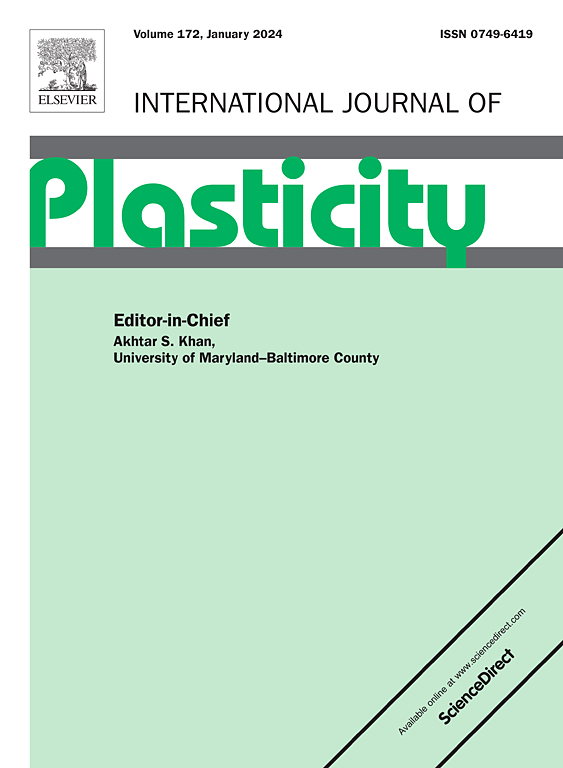A fully coupled rate- and temperature-dependent viscoplastic damage model for rock-like materials within the consistency framework
IF 9.4
1区 材料科学
Q1 ENGINEERING, MECHANICAL
引用次数: 0
Abstract
Civil structures in the deep lithosphere are frequently exposed to thermal environments resulting from geothermal gradients and dynamic disturbances caused by blasting, rockbursts, and earthquakes during construction and operation. In this paper, a novel thermo-viscoplastic damage model is proposed within the consistency framework to capture the rate- and temperature-dependent behavior of rock-like materials. By rationally designing the free energy and dissipation potential functions, all the constitutive formulations relating the coupled thermo-elasto-viscoplastic-damage processes can be derived following the thermodynamic principle. The main innovation of our study lies primarily in deriving a fully coupled Lagrange multiplier satisfying the classical form of rate-independent plasticity while still retaining the rate-dependent characteristics, thus enabling a consistent solution for the viscoplastic strain, temperature, and damage variables. To better improve the usability of our model, a hierarchical procedure is formulated for identifying all model parameters based on conventional laboratory experiments. By reproducing a series of uniaxial/triaxial compression, SHPB tests, and large-scale impact tests across a broad range of pressures, strain rates, and temperatures, the proposed consistency thermo-viscoplastic damage model is proven able to characterize realistically the coupled dynamic and thermal responses, as well as corresponding failure patterns of rock-like materials. Our calculations show that greater thermal damage intensifies the strain rate sensitivity of dynamic rock strength. Moreover, we have newly discovered the competitive relations among different dissipation processes during inelastic material deformation, highlighting the potential application of our model in predicting the temperature evolution in geological fault zones associated with distributed rock fracturing and pulverization.
稠度框架下类岩石材料的完全耦合速率和温度依赖粘塑性损伤模型
岩石圈深处的土木工程结构在施工和运行过程中经常暴露在地热梯度和爆破、岩爆和地震引起的动态扰动所造成的热环境中。本文在一致性框架内提出了一种新型热粘塑性损伤模型,以捕捉类岩石材料随速率和温度变化的行为。通过合理设计自由能和耗散势函数,可以根据热力学原理推导出所有与热弹性-粘弹性-损伤耦合过程相关的构成公式。我们研究的主要创新点在于推导出一个完全耦合的拉格朗日乘法器,既满足速率无关塑性的经典形式,又保留了速率相关特性,从而使粘塑性应变、温度和损伤变量的解法保持一致。为了更好地提高模型的可用性,我们在传统实验室实验的基础上制定了一个分层程序来确定所有模型参数。通过在广泛的压力、应变率和温度范围内再现一系列单轴/三轴压缩、SHPB 试验和大规模冲击试验,证明了所提出的一致性热粘塑性损伤模型能够真实地描述类岩石材料的动态和热耦合响应以及相应的破坏模式。我们的计算表明,较大的热损伤会加剧岩石动态强度的应变速率敏感性。此外,我们还新发现了非弹性材料变形过程中不同耗散过程之间的竞争关系,凸显了我们的模型在预测与分布式岩石断裂和粉碎相关的地质断层带温度演变方面的潜在应用。
本文章由计算机程序翻译,如有差异,请以英文原文为准。
求助全文
约1分钟内获得全文
求助全文
来源期刊

International Journal of Plasticity
工程技术-材料科学:综合
CiteScore
15.30
自引率
26.50%
发文量
256
审稿时长
46 days
期刊介绍:
International Journal of Plasticity aims to present original research encompassing all facets of plastic deformation, damage, and fracture behavior in both isotropic and anisotropic solids. This includes exploring the thermodynamics of plasticity and fracture, continuum theory, and macroscopic as well as microscopic phenomena.
Topics of interest span the plastic behavior of single crystals and polycrystalline metals, ceramics, rocks, soils, composites, nanocrystalline and microelectronics materials, shape memory alloys, ferroelectric ceramics, thin films, and polymers. Additionally, the journal covers plasticity aspects of failure and fracture mechanics. Contributions involving significant experimental, numerical, or theoretical advancements that enhance the understanding of the plastic behavior of solids are particularly valued. Papers addressing the modeling of finite nonlinear elastic deformation, bearing similarities to the modeling of plastic deformation, are also welcomed.
 求助内容:
求助内容: 应助结果提醒方式:
应助结果提醒方式:


